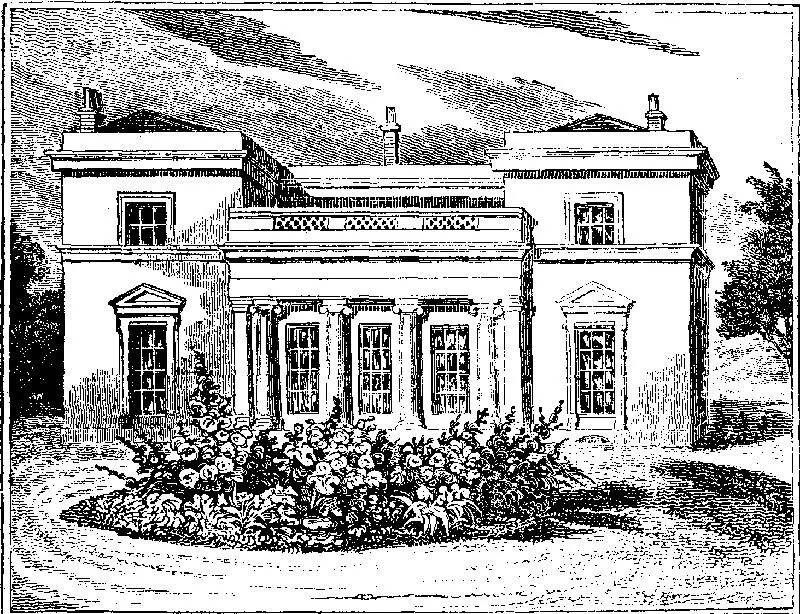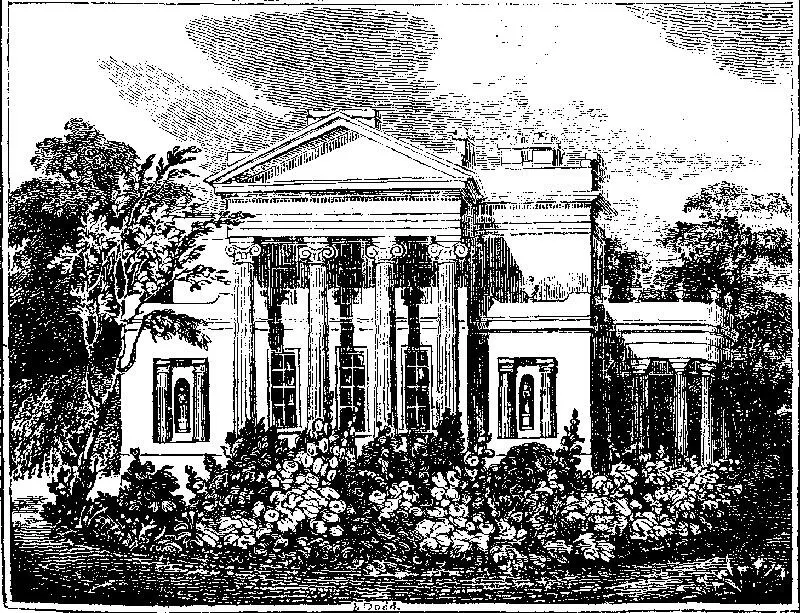Various - The Mirror of Literature, Amusement, and Instruction. Volume 13, No. 353, January 24, 1829
Здесь есть возможность читать онлайн «Various - The Mirror of Literature, Amusement, and Instruction. Volume 13, No. 353, January 24, 1829» — ознакомительный отрывок электронной книги совершенно бесплатно, а после прочтения отрывка купить полную версию. В некоторых случаях можно слушать аудио, скачать через торрент в формате fb2 и присутствует краткое содержание. Жанр: foreign_antique, periodic, Развлечения, foreign_edu, на английском языке. Описание произведения, (предисловие) а так же отзывы посетителей доступны на портале библиотеки ЛибКат.
- Название:The Mirror of Literature, Amusement, and Instruction. Volume 13, No. 353, January 24, 1829
- Автор:
- Жанр:
- Год:неизвестен
- ISBN:нет данных
- Рейтинг книги:3 / 5. Голосов: 1
-
Избранное:Добавить в избранное
- Отзывы:
-
Ваша оценка:
- 60
- 1
- 2
- 3
- 4
- 5
The Mirror of Literature, Amusement, and Instruction. Volume 13, No. 353, January 24, 1829: краткое содержание, описание и аннотация
Предлагаем к чтению аннотацию, описание, краткое содержание или предисловие (зависит от того, что написал сам автор книги «The Mirror of Literature, Amusement, and Instruction. Volume 13, No. 353, January 24, 1829»). Если вы не нашли необходимую информацию о книге — напишите в комментариях, мы постараемся отыскать её.
The Mirror of Literature, Amusement, and Instruction. Volume 13, No. 353, January 24, 1829 — читать онлайн ознакомительный отрывок
Ниже представлен текст книги, разбитый по страницам. Система сохранения места последней прочитанной страницы, позволяет с удобством читать онлайн бесплатно книгу «The Mirror of Literature, Amusement, and Instruction. Volume 13, No. 353, January 24, 1829», без необходимости каждый раз заново искать на чём Вы остановились. Поставьте закладку, и сможете в любой момент перейти на страницу, на которой закончили чтение.
Интервал:
Закладка:
Various
The Mirror of Literature, Amusement, and Instruction / Volume 13, No. 353, January 24, 1829
VILLAS IN THE REGENT'S PARK


The villas of this district are among the most pleasing of all the architectural creations that serve to increase its picturesque beauty. Their structure is light and elegant, and very different from the brick and mortar monstrosities that line the southern outlets of London.
The engravings on the annexed page represent two of a group seen to advantage from Macclesfield Bridge, pictured in our 351st Number. The first is
HANOVER LODGE,
the residence of Colonel Sir Robert Arbuthnot, K.C.B. The architectural simplicity and beauty of this mansion can scarcely fail to excite the admiration of the beholder. The entrance is by a handsome portico; and the internal accommodations combine all the luxuries of a well-proportioned dining-room, and a splendid suite of drawing-rooms, extending above sixty feet in length, by eighteen feet in breadth. The upper story comprises nine chambers, bathing-room, dressing-rooms, &c.; and the domestic offices are in the first style of completeness.
The grounds are unusually picturesque, for they have none of the geometrical formalities of the exploded school of landscape-gardening, or of Nature trimmed and tortured into artificial embellishment. We have often wondered where the old gardeners acquired their mathematical education; they must have gone about with the square and compasses in their pockets—for knowledge was then clasped up in ponderous folios.
The second engraving is
GROVE HOUSE,
the elegant residence of George Bellas Greenough, Esq., built from the designs of Mr. Decimus Burton. This is a happy specimen of the villa style of architecture. The garden front, represented in the print, is divided into three portions. The centre is a tetrastyle portico of the Ionic order, raised on a terrace. Between the columns are three handsome windows. The two wings have recesses, "the soffites of which are supported by three-quarter columns of the Doric order. Between these columns are niches, each of which contains a statue. The absence of other windows and doors from the front," (observes Mr. Elmes,) "gives a remarkable and pleasing casino or pleasure-house character to the house."
The portico is purely Grecian, and the proportion of the pediment very beautiful. The entrance front also consists of a centre and two wings; but the former has no pediment. The door is beneath a spacious semicircular portico of the true Doric order, which alternates with the Ionic in the other parts of the building with an effect truly harmonious.
Of the internal arrangements of Grove House we will vouch; but our artist has endeavoured to convey some idea of the natural beauties with which this little temple of art is environed; and the engraver has added to the distinctness of the floral embellishments in the foreground. Altogether, the effect breathes the freshness and quiet of a rural retreat, although the wealth and fashion of a metropolis herd in the same parish, and their gay equipages are probably whirling along the adjacent road.
The exterior of the "COLOSSEUM" (of the interior of which building our last Number contained a description) was intended for the embellishment of the present Number. Our engraver promised—but, as Tillotson quotes in one of his sermons, "promises and pie-crusts," &c. The engraving is, however, intended for our next MIRROR, with some additional particulars of the interior, &c.
SEVERE FROST
On the 25th of December, 1749, a most severe frost commenced; it continued without intermission for several weeks, during which time the people, especially the working classes, experienced dreadful hardships. Many travellers were frozen to death in coaches, and even foot passengers, in the streets of London, shared the same fate. Numerous ships, barges, and boats, were sunk by the furious driving of the ice in the Thames. Great were the distresses of the poor, and even those who possessed all the comforts of life, confined themselves within doors, for fear of being frozen if they ventured abroad.
The watermen of the river received great assistance from merchants, and other gentlemen of the Royal Exchange; but the fishermen, gardeners, bricklayers, and others, were reduced to a miserable extremity. These poor men, presenting a sad aspect, assembled to the number of several hundreds, and marched through the principal streets of the metropolis, begging for bread and clothing. The fishermen carried a boat in mourning, and the unfortunate mechanics exhibited their implements and utensils. The citizens of London contributed largely to their relief, as did most of the inhabitants of the main streets through which the melancholy procession passed.
OTWAY, THE POET
Any anecdote relating to, or illustrative of, the works of this great man is a public benefaction; and I, in common with all your readers, (no doubt,) feel obliged to your correspondent for his history of Charles Brandon, Duke of Suffolk; at least, so much of it as, it would seem, was connected with the tragedy of the Orphan. Charles Brandon was, as history informs us, a gay, young, rattling fellow, a constant exhibitant at all tilts and tournaments at Whitehall and elsewhere; courageous, "wittie and of goodlie persone," in fact, a regular dandy of bygone days, a fine gallant, and of course a great favourite of his royal master; but, notwithstanding all this, it is not clear to me that Charles Brandon and his brother were the romantic originals of Polydore and Castalio. I rather think, if Otway did form his characters on any real occurrence of the sort, the distressing event must be laid to the noble family now proprietors of Woburn.
Perhaps the old nobleman misunderstood the duchess-dowager when she explained the picture to him; or perhaps her grace did not choose to be quite so communicate as she could have been, and, therefore, fixed the sad event upon the gay Charley Brandon, in whose constellation of gay doings it would, indeed, be a romantic diamond of the first water.
Every body who knows the gallery at Woburn, must remember the remarkable picture alluded to. There is in the same apartment a very fine whole-length of Charles Brandon; but in no way can I see is it connected with the work which has furnished this tragic anecdote. At some distance from Brandon's portrait appears the first Francis, Earl of Bedford , with a long white beard, and furred robe, and George, pendant,—an illustrious personage of this house, who discharged several great offices in the reigns of Mary and Elizabeth. Such was his hospitality, that Elizabeth used good-humouredly to say, "Go to, Frank, go to; it is you make all the beggars." He died, aged 58, on the 28th of July, 1585, the day after his third son, Francis , was slain, happily unapprized of the misfortune.
Now comes the interesting picture in connexion with Otway and his play. This youth, Francis and his elder brother, the Lord Edward Russell, are represented in small full-lengths, in two paintings; and so alike, as scarcely to be distinguished one from the other; both dressed in white, close jackets, and black and gold cloaks, and black bonnets. The date by Lord Edward is aet. 22, 1573. He is represented grasping in one hand some snakes with this motto, Fides homini, serpentibus fraus ; and in the back ground he is placed standing in a labyrinth, above which is inscribed, Fata viam invenient . This young nobleman died before his father. His brother Francis has his accompaniments not less singular. A lady, seemingly in distress, is represented sitting in the back ground, surrounded with snakes, a dragon, crocodile, and cock. At a distance are the sea and a ship under full sail. He, by the attendants, was, perhaps, the Polydore of the history. Edward seems by his motto, Fides homini, serpentibus fraus , to have been the Castalio, conscious of his own integrity, and indignant at his brother's perfidy. The ship probably alludes to the desertion of the lady. If it conveyed Francis to Scotland, it was to his punishment, for he fell on July 27, 1585, in a border affray, the day before his father's death.
Читать дальшеИнтервал:
Закладка:
Похожие книги на «The Mirror of Literature, Amusement, and Instruction. Volume 13, No. 353, January 24, 1829»
Представляем Вашему вниманию похожие книги на «The Mirror of Literature, Amusement, and Instruction. Volume 13, No. 353, January 24, 1829» списком для выбора. Мы отобрали схожую по названию и смыслу литературу в надежде предоставить читателям больше вариантов отыскать новые, интересные, ещё непрочитанные произведения.
Обсуждение, отзывы о книге «The Mirror of Literature, Amusement, and Instruction. Volume 13, No. 353, January 24, 1829» и просто собственные мнения читателей. Оставьте ваши комментарии, напишите, что Вы думаете о произведении, его смысле или главных героях. Укажите что конкретно понравилось, а что нет, и почему Вы так считаете.












